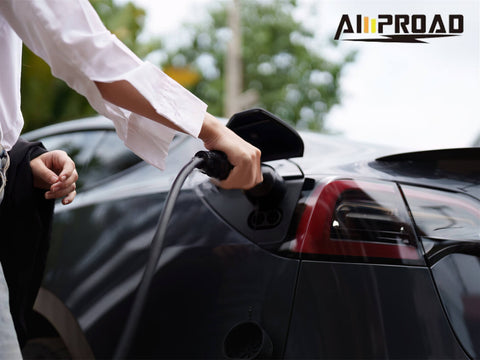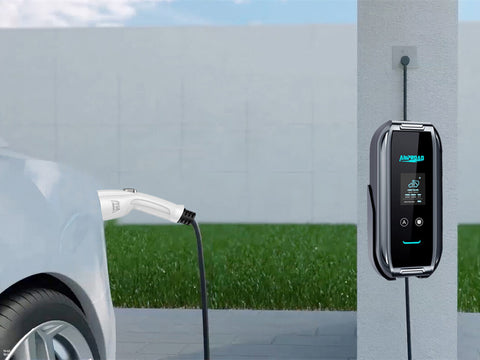
Maintaining a healthy Electric Vehicle battery is crucial for optimal performance and longevity. Regular care, such as avoiding extreme temperatures, adhering to recommended charging practices, and periodic software updates, ensures efficient energy storage and sustained driving range. Neglecting battery health may result in diminished capacity, reduced range, and increased charging times. As EVs become integral to sustainable transportation, prioritizing battery maintenance not only enhances individual vehicle performance but also contributes to the overall success and acceptance of electric mobility, fostering a cleaner and more eco-friendly automotive future.
Amproad Powers the Future: Leading North America in Level 2 EV Charging Excellence
Amproad has emerged as a distinguished leader in Level 2 EVSE chargers within the North American market. With a dedicated focus on innovation and sustainable mobility solutions, Amproad has strategically positioned itself as a frontrunner in providing state-of-the-art charging infrastructure tailored to the specific needs of the North American landscape. Renowned for its comprehensive understanding of Level 2 charging technology, Amproad delivers solutions that not only meet but exceed industry standards and regulations.
The company's leadership in the Level 2 EV charger sector is characterized by cutting-edge features and user-friendly design, ensuring seamless integration into diverse charging networks across North America. Amproad's solutions cater not only to individual EV owners but also to businesses, municipalities, and other key stakeholders committed to advancing sustainable transportation in the region. Through strategic collaborations, robust research and development initiatives, and a steadfast commitment to customer satisfaction, Amproad has solidified its status as a trusted authority in North America's rapidly expanding EV charging sector.
As the demand for electric vehicles continues to grow in North America, Amproad's innovative solutions position the company as a trailblazer, actively contributing to and shaping the region's transition towards a more sustainable and electrified transportation ecosystem.
Elevating Home Charging

The Charger House stands as a beacon of excellence in the realm of Electric Vehicle (EV) charging, offering a distinctive advantage in its commitment to providing top-tier charging solutions. At the heart of this advantage is the Charger House's unwavering dedication to quality, positioning itself as a symbol of trust and innovation in the rapidly evolving landscape of electric mobility. By prioritizing reliability and efficiency, the Charger House has become synonymous with cutting-edge technology, setting the standard for home EV charger.
One key facet of the Charger House Advantage lies in its emphasis on affordability without compromising on safety. The chargers offered by Charger House undergo rigorous safety tests, ensuring a secure and reliable charging experience for users. This commitment to stringent safety standards not only instills confidence in users but also contributes to fostering a sense of trust in the broader context of home EV charger. As the demand for residential EV chargers continues to rise, Charger House's affordable like AMPROAD portable EVSE yet robust solutions play a pivotal role in democratizing access to sustainable transportation.
The EV charging stations Advantage extends beyond merely providing a charging solution; it embodies a holistic approach to supporting the growing community of electric vehicle enthusiasts. The affordable chargers not only meet but exceed safety benchmarks, reflecting a commitment to the longevity and resilience of the charging infrastructure. In doing so, the Charger House establishes itself as a reliable partner for individuals seeking a secure and efficient home charging solution, contributing significantly to the widespread adoption of electric vehicles in communities across the globe.
How to Change A Car Battery?
Changing a car battery is a task that, while seeming daunting to some, is relatively straightforward and can be accomplished with minimal hassle. Whether your battery is aging or has reached the end of its life, following these general steps will guide you through the process of replacing your car battery, ensuring a smooth and efficient transition.
Step 1: Safety First
Before diving into the intricacies of changing a car battery, it's crucial to prioritize safety. Start by parking your vehicle in a well-ventilated area, away from heat sources or open flames. Ensure the ignition is turned off, and put on safety gear, such as gloves and safety glasses, to protect yourself from any potential hazards.
Step 2: Identify the Battery Location
Pop the hood of your car and locate the battery. In most vehicles, the battery is situated near the engine, often on one side. If you're uncertain about its placement, consult your vehicle's manual for guidance. Once identified, take note of the positive and negative terminals.
Step 3: Disconnect the Cables
Using a wrench or the appropriate tool, start by disconnecting the negative cable first. This is typically marked with a minus (-) sign and is crucial for preventing any electrical mishaps. Once the negative cable is safely removed, proceed to detach the positive cable, marked with a plus (+) sign.
Step 4: Remove the Old Battery
With both cables disconnected, carefully remove the old battery. Batteries are often secured with a bracket or strap. Loosen any fasteners and gently lift the battery out of its compartment. Exercise caution, as car batteries can be heavy.
Step 5: Clean the Battery Tray
Before placing the new battery, take a moment to clean the battery tray. Remove any debris or corrosion using a mixture of baking soda and water. This ensures a clean and stable environment for the new battery.

Step 6: Install the New Battery
Carefully place the new battery into the tray, ensuring it is positioned correctly. Tighten any fasteners to secure the battery in place. Begin by connecting the positive cable, followed by the negative cable. Ensure the connections are snug to prevent any wobbling.
Step 7: Final Checks
Once the new battery is securely in place, perform a final check. Ensure all connections are tight, and there is no debris around the battery. Close the hood and start your vehicle to confirm that the new battery is functioning correctly.
By following these comprehensive steps, changing your car battery becomes a manageable task. Remember, if you encounter any challenges or are uncomfortable with the process, seeking professional assistance is always a prudent option. Taking the time to perform this task diligently ensures a reliable power source for your vehicle, contributing to its overall longevity and performance. And if you have a gas car, you may be interested to know how to use jumper cables, that's not a difficult thing by following the guide.
Battery Maintaining Tips
Mention about the automotive troubleshooting, it's crucial not to hastily attribute vehicle issues to a malfunctioning battery. While a dead battery might seem like the obvious culprit, underlying problems could involve more intricate components, such as a faulty alternator or starter motor. To accurately pinpoint the true cause of vehicular maladies, professionals often recommend a comprehensive diagnostic test. This approach not only ensures a more precise identification of the issue but also prevents unnecessary expenses and efforts spent on replacing a battery that may not be the primary source of the problem.
The increasing complexity of today's vehicles amplifies the importance of a nuanced diagnostic approach. For example, there are always people ask, how long does it take to charge a Tesla, well, the answer is, that's depends, if you charge tesla 110v via level 2 ev charger with an adapter cord 14 50, it won't take too long time. Modern cars are equipped with an array of on-board computers and sophisticated electronic systems. These advancements, while contributing to improved efficiency and performance, also render vehicles more susceptible to electrical issues. The intricacies of these advanced systems necessitate a careful examination by professionals equipped with the right tools and expertise to navigate the complexities of modern automotive technology.
When confronted with a suspected battery problem, it's prudent to acknowledge the intricacies of contemporary vehicle systems and the potential for short circuits. Unlike the straightforward mechanics of older vehicles, the presence of numerous electronic components in modern cars raises the likelihood of electrical malfunctions. Hence, the assumption that a dead battery is the sole cause of vehicular troubles might oversimplify the issue. Opting for a professional diagnostic test becomes not just a recommendation but a strategic move to unravel the complexities embedded in the modern automotive landscape.

During the replacement of a vehicle's battery, professionals take meticulous precautions to safeguard the integrity of the car's computerized systems. One critical step involves ensuring the availability of a secondary power source. This precautionary measure prevents the loss of essential computer settings, preserving configurations related to engine performance, emissions control, and various other critical functions. Additionally, it safeguards security codes integral to the proper operation of certain vehicle features.
Preserving computer settings during a battery replacement is vital to preventing a cascade of issues that may arise from a reset of the vehicle's electronic configurations. Modern cars heavily rely on these settings to maintain optimal performance and efficiency. Without proper precautions, a seemingly routine battery replacement could result in a loss of critical data, leading to disruptions in the seamless operation of various vehicle systems. Thus, the inclusion of a secondary power source in the replacement process is a testament to the meticulous care professionals exercise in handling the delicate balance of a vehicle's electronic components.
An often overlooked consequence of a battery replacement is the potential loss of the radio security code. This four to a six-digit code is a security feature designed to deter theft of the vehicle's radio. In the event that the radio security code is not documented in the car manual or other accessible records, vehicle owners may find themselves in a predicament when attempting to operate the radio post-battery replacement.
Locating the radio security code can be a challenging task, and if not readily available, vehicle owners typically resort to reaching out to their car dealer for assistance. However, this convenience may come at a cost, as some dealerships impose fees for retrieving the radio security code. While the fee might be a minor inconvenience compared to the benefits of having a functioning radio, it underscores the importance of maintaining records of such codes and being aware of their location within the vehicle's documentation.


